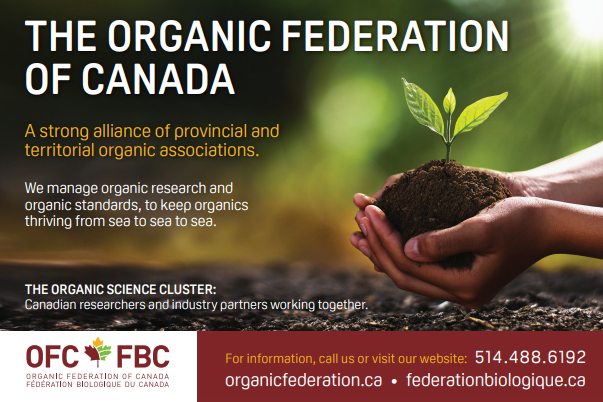by Nicole Boudreau
Organic Federation of Canada
The word ‘regenerative’ is appealing: we all want to regenerate! It is a promise of prolonged youthfulness, of vitality for both our people and our soils.
Regenerative agriculture is being promoted everywhere, both by the proponents of conventional intensive agriculture, such as General Mills, and by the Rodale Institute, which created a whole new form of organic certification by providing specific requirements for regenerative practices. How does organic agriculture fit into this context of promoting regenerative agriculture? Is there a practical need to regenerate organic soils? Does the Canadian Organic Standards (COS) include practices that care for the soil?
A fertile soil is a healthy soil #
Soil is the foundation of organic production. Section 5.4 of the COS, Soil Fertility and Nutrient Management, specifies that organic farmers shall establish and maintain soil fertility by preserving and increasing soil organic matter, while aiming for an optimal balance of nutrients and stimulating soil biological activity.
Soil fertility is promoted through crop rotation, including green manures, catch crops, legumes or deep-rooted plants (5.4.2 a); the use of compost and animal manure (5.4.2 b); and tillage that maintains the physical, chemical and biological condition of the soil. Organic farmers are required to minimize damage to the soil structure and prevent erosion (5.4.3).
Furthermore, the plant and animal materials used to maintain and improve soil health must not contaminate crops, soil and water (excess nutrients, pathogens, heavy metals or other prohibited substances) (5.5.4). In fact, Section 5.5.2 is devoted to the ecological application of
animal manure.
Management of pests (insects, diseases and weeds) includes cultural practices (crop rotations, resistant varieties and maintenance of a balanced ecosystem), mechanical methods (tillage, mulching) and physical methods (such as
burning weeds).
The Organic Standards clearly place soil fertility at the forefront. In fact, the COS prohibits hydroponics and aeroponics. Since regenerative agriculture places ‘no-till’ as an essential practice for maintaining soil health, how can we ensure that organic soils remain healthy when tillage is used to control weeds? Is an organic soil a healthy soil?
What makes a healthy soil? #
Soil health is a moving target. Weather conditions, crop type, farming practices, seasonal cycles…all these factors and more influence soil quality and fertility. The challenge for any producer concerned about preserving soil health is to maintain the balance, to analyze the impact of the farming practices applied season after season and adjust accordingly. For example, after growing crops with high nutrient demands, the soil will be treated with particular care. Its nutrient reserves and organic matter can be replenished by sowing cover crops or green manure, or applying compost to protect and feed the soil microorganisms.
After tillage has been used, the producer might plant a forage crop, sow a green manure, mulch the soil or find another way to provide ground cover. In doing so, soil life is supported and the soil aggregates that support soil structure are re-established. These practices largely compensate for the much-discussed disadvantages of tillage. Furthermore, tillage is a valuable tool in incorporating green manures, crop residue and other organic matter that helps feed soil life.
Maintaining healthy soil #
Using catch crops (5.4.2 a) between cropping seasons traps nutrients to limit leaching and keeps the ground covered. They (and other cover crops) also protect the soil when planted between crop rows.
It should also be noted that the prohibition of reliance on synthetic fertilizers, fungicides and insecticides in organic production preserves the vitality of soil life. The soil organisms break down organic matter and make it available to plants, an important parameter of soil health.
The principles and practices of the COS therefore benefit soil health. The Regenerative Organic Alliance (of which Rodale is a key member) has developed Regenerative Organic Certification (ROC). This requires basic organic certification for any product that qualifies as regenerative. Regenerative organic certification distinguishes itself by placing greater emphasis on permanent cover for crop land.
In reality, organic fields are most often covered. One rarely sees bare organic soil because of the requirement to maintain soil fertility (5.4.1) through crop rotation, by growing green manures and applying compost, aged manure and other organic materials.
Soil regeneration in greenhouses #
Since 2009, the Canadian Organic Standards allow plants, usually greenhouse crops, to be grown in containers but only under strict restrictions (7.5). This includes a minimum volume of soil according to the type of crop and culture. Minimum conditions must be respected in order to maintain the health of the soil in the containers. The physical structure of the soil must be composed of a mineral fraction (sand, silt, clay) and an organic fraction. The soil shall contain at least 10 per cent by volume of compost and at least two per cent of minerals by dry weight or volume.
Additional compost applications should be part of the fertilization program (7.5.2.4 a). The COS also recommends soil regeneration in greenhouses and similar structures through the introduction of biodegradable plant mulches (straw or hay) (7.5.9). In addition, substances in Table 4.2 of the Permitted Substances Lists can be used to maintain soil fertility in containers.
Unhealthy soil is not fertile, so the COS focuses extensively on soil health in greenhouse production. However, greenhouse products will never be labeled ‘grown under regenerative agriculture’ given that the current standard for Regenerative Organic Certification does not allow crops to be grown in containers, other than for seedlings that will later be transplanted in the field. The Canadian organic industry’s choice to include greenhouse production in the COS is legitimate as greenhouse production extends the growing season and provides much needed fresh greens and vegetables to those in colder climates.
Are organic soils healthy? The COS is reviewed every five years to reassess or introduce best practices that will maintain soil fertility. Soil quality depends on the combination of practices applied season after season. It results from the balance between the supply of nutrients to the soil and the assimilation of nutrients by the plants. The soil regenerates itself when organic practices are applied consistently year after year.

The Organic Science Cluster 3 is led by the Organic Federation of Canada in collaboration with the Organic Agriculture Centre of Canada at Dalhousie University, and is supported by the AgriScience Program under Agriculture and Agri-Food Canada’s Canadian Agricultural Partnership (an investment by federal, provincial and territorial governments) and over 70 partners from the agricultural community.
This magazine may be cited as: Geldart, E.. Graves, M.E., Boudreau, N., Wallace, J., and Hammermeister, A.M. (Editors). 2022. Organic Science Canada. Volume 4. Organic Federation of Canada, Montreal, QC and Dalhousie University, Truro, NS. 40 pp. www.dal.ca/oacc/oscIII


